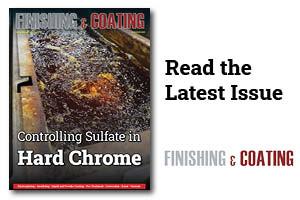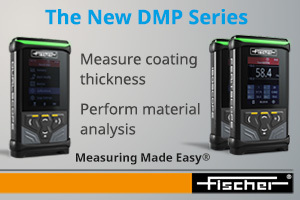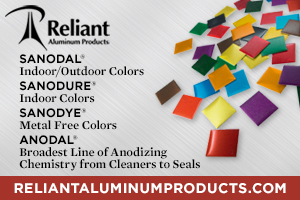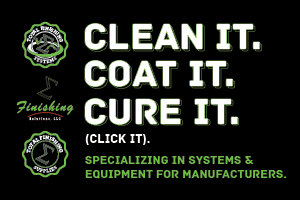A plating shop was having issues with its high-temperature black oxide process, as their parts were not meeting salt spray requirements.
 Frank AltmayerBlack is a widely used color in the electrolytic or chemical processes of metal coloring and, except the phosphate coatings, is the predominant conversion coating for iron and steel. It can be produced by multiple processes with the aqueous alkali-nitrate solution, the most frequently used. Colors range from matte gray to glossy jet-black.
Frank AltmayerBlack is a widely used color in the electrolytic or chemical processes of metal coloring and, except the phosphate coatings, is the predominant conversion coating for iron and steel. It can be produced by multiple processes with the aqueous alkali-nitrate solution, the most frequently used. Colors range from matte gray to glossy jet-black.
Black oxide coatings have a fair amount of corrosion resistance that is closely tied to the quality of oil applied after the oxide coating is formed. Black oxide coatings aid in lubrication because the coating reduces the coefficient of friction of the metal surface. They are, therefore, well suited for moving parts that cannot tolerate the dimensional buildup of a more corrosion-resistant finish. The black finish minimizes light reflection. This property makes the black finish a preferable finish for optical, electrical, and photographic equipment and the military’s production of defense systems and weaponry. Black finishes also increase the heat absorption of a metal and reduce its heat reflection properties.
Bare (oil-free) black oxide coatings are not recommended on parts going into long-term storage. If long-term storage is required, a protective preservative fluid is recommended, or a desiccated package may be used. A supplementary water-displacing preservative coating, such as MIL-C 16173, grade 3, can also be applied.
Black Oxide Coatings Overview
While there are numerous methods of producing oxide coatings on ferrous substrates, the most common method employs sodium hydroxide and oxidizers, such as sodium nitrate, plus chlorates, peroxides, permanganates, dichromates, and other proprietary oxidizers, to produce a black oxide finish on steel. This process has advantages over the other methods, such as more consistent coating performance, low-temperature application, successful application on a wide variety of alloys, and ease of process control.
When ferrous parts are immersed in this solution, the iron on the surface is converted to iron oxide. While common iron oxide (Fe2O3) is known as rust and is reddish brown, the black oxide solution produces an alternate form of iron oxide [Fe3O4, more correctly written as Fe(FeO2)2], which has a color similar to charcoal. Any carbon particles and other nonferrous alloying elements are not converted by the solution. They may be left behind to form an adherent powder or off-color coatings if the solution is not capable of removing them. The corrosion resistance of black oxide coatings is low, with low-carbon steel yielding the highest level of protection. If black oxide coatings are exposed to weathering and salt spray, additional measures need to be taken to improve corrosion resistance. A protective coating of oil, lacquer, or wax may be required.
The purpose of applying black oxide coatings that will retain an oil film is to increase the anti-chafing and anti-friction properties of carbon and low-alloy steel parts, particularly those that are involved in sliding or bearing surfaces.
Black oxide coating thicknesses range from 0.00006 to 0.0001 in. Thicker coatings are possible with longer immersion times, but they run the risk of producing a loose film and poor corrosion resistance. Dimensional changes are minimal (<0.00001 in.).
While low-temperature black oxidizing processes are commercially available, the high-temperature process remains in general use because of its overall performance advantages.
Coating Mechanism
Black oxide is a conversion coating process. Such coatings are produced through a chemical reaction with the metallic surface of the part to be coated. Ferrous substrates react with nitrates in a hot alkaline-water mixture to form a ferri-ferro-oxide [Fe(FeO2)2]. While the most common oxidation product of iron is ferric oxide (commonly referred to as “rust”), which is reddish brown, ferriferro-oxide is near-black in color and is slightly porous, and serves as a fair corrosion-resistant barrier when the porosity in the oxide is impregnated with oil. Proprietary chemical formulations contain a variety of additional oxidizers to enhance and quicken the chemical reaction.
To cause the chemical reaction to proceed requires a significant amount of energy. The typical reaction temperature range is 240°F to 305°F (116°C to 152°C). Typical reaction time is 15-30 minutes.
Preparation for Black Oxide Coating
Cleaning and acid pickling to remove surface grease/oil, and oxides are essential steps in preparing a ferrous surface for black oxide coating. The cleaning process typically involves a soak cleaner followed by acid pickling.
After cleaning, the metal is immersed in the black oxide process solution.
The Black Oxide Process
The intensity of black oxide color is dependent upon the time of immersion and the solution temperature. Immersion for 15-30 min in a solution operating between 240°°F and 305°°F (116 °°C and 152 °°C) is common with single-solution treatments.
One method of improving both the corrosion and abrasion resistance of the parts is to use the same blackening solution as a two-stage process, operating the first treatment at 211F-220F (100C-115C), and the second treatment at 247F-256F (118C-123C). Other frequently used methods to improve corrosion and abrasion resistance are the two- or three-stage blackening processes that use solutions of different composition and increased operating temperatures.
In one alternate two-stage process, the parts are immersed in the initial solution that is boiling at temperatures from 280°°F to 293°°F for 15 min. After this first immersion, the parts are immediately immersed in a second blackening solution. This solution is also boiling at a temperature of 310°°F -315°°F. The immersion time in the final solution is 15-20 min. An exception is with carburized parts, for which the solution temperature should not exceed 300°°F.
Table 1 shows a typical sequence for a three-stage process (obtained from Ref. #1 and covered by German Patent 704.400):
| Parts/Weight | |
| Solution 1; 125-135 °C (257-275 °F) | |
| Caustic Soda | 75 |
| Disodium Phosphate | 16.5 |
| Sodium Nitrate | 5 |
| Solution 2; 130-138 °C (266-280 °F) | |
| Caustic Soda | 60 |
| Sodium Nitrate | 40 |
| Solution 3; 145-160 °C (293-320 °F) | |
| Caustic Soda | 60 |
| Disodium Phosphate | 10 |
| Trisodium Phosphate | 14 |
| Sodium Nitrite | 3 |
This process has been reported to produce coatings with twice the corrosion resistance and approximately four times the abrasion resistance of coatings obtained by a single-stage blackening process.
Table 2 is a typical processing sequence for MIL-C-13924C Class 1. Alternate processing sequences per other specifications can also be performed (see Table 3).
| Process | Tank Contents | Time min | Temperature °F |
| Vapor Degrease | 100% trichloroethylene | 3-5 | 180 |
| Hot Water Rinse Blow Dry | 1 | 160 | |
| Black Oxide | 112 oz/gal | 6-75 | 180-295 |
| Hot Water Rinse | 1-2 | 180 | |
| Cold Water Rinse | 1-2 | Ambient | |
| Neutralize | Na2Cr2O7; 0.06 oz/gal | 0.5-1 | 150 |
| Blow Dry | |||
| Inspect | |||
| Oil | 1-2 | Ambient |
Table 3
| Process | Tank Contents | Time; min | Temperature; °F |
| Vapor Degrease | Trichloroethylene | 5 | 180 |
| Alkaline Cleaning | Proprietary | 10-20 | 180-200 |
| Cold Water Rinse | 1 | Ambient | |
| Hot Water Rinse | 2 | 140-190 | |
| Blow Dry | |||
| Black Oxide | Proprietary | 45-60 | 285-290 |
| Hot Water Rinse | 1 | 140-190 | |
| Cold Water Rinse | 5-6 | Ambient | |
| Neutralize | Na2Cr2O7;0.06 oz/gal | 5-6 | 160-190 |
| Blow Dry | |||
| Inspect | |||
| Test | |||
| Bake | 2-4 hr | 302±5 °F | |
| Oil | 1-2 | Ambient |
Following cleaning and rinsing, a water film break test is conducted. Water breaks indicate poor cleaning and a need to re-process the parts through the cleaning cycle. The parts are then blown dry with compressed air before immersion in the black oxide to avoid splattering from the hot caustic.
After the black oxide process, parts are thoroughly drained and rinsed in stagnant warm water (140°F -190°F), followed by a minimum of five-minute running cold-water rinse and finally a hot-water rinse (160°F -190°F) for another minimum of five min. An optional addition of two percent potassium dichromate may be added to this rinse.
Following air drying of the parts, quality control tests are performed. Upon passing these tests, parts may be baked within four hr of the black oxide application. The parts are baked for 2-4 hr at 302°°F. The final step in the process will be the application of an anticorrosive oil.
Oil Quality Issues
Several cases of poor corrosion resistance on parts coated with black oxide and oil have been solved by simply replacing the oil with a superior product. Poor salt spray performance should be investigated along the lines of process parameters/chemistry, and oil quality. The salt spray testing of black oxide and oil parts must be carefully conducted on parts that have been handled as little as possible (preferably with plastic gloves). Also, the parts should not be tested after prolonged storage (more than 2-5 days) or if packaged in absorbent media, such as paper.
Solution Contamination Because the blackening solution is highly alkaline, zinc, aluminum, cadmium, and copper contamination should be avoided, as even small amounts of these contaminants can affect the color of the finish.
Post Coating Processing
After the black oxide coating is formed, parts are rinsed. Corrosion resistance is enhanced by an immersion in 0.06 to 1 oz/gal chromic acid or sodium dichromate solution to neutralize the alkaline film. A hot-water rinse follows the cold rinse, after which the parts are dried. Clean, compressed air may be used to reduce the drying time.
Agitation (air or mechanical) during rinsing and chromic acid dipping helps wash the trapped salts from blind holes and crevices. The parts may then be oiled (at least two minutes with frequent agitation) or finished with lacquer or enamel by dipping or spraying.
Finished parts that are to be stored for more than seven days after treatment should be protected with a soft film corrosion-preventive compound and wrapped in greaseproof material. Finished parts that are to be stored for more than 60 days after treatment should be protected with a soft film corrosion-preventive compound and wrapped in greaseproof material.
Quality Control Tests
Coating requirements specified in AMS 2485G and other internal corporate specifications include the following tests.
Smut Test: The smut test is performed by wiping the coated part with a clean, white cloth. A part passes the smut test if no indication of reddish-brown or green smut appears on the cloth. The smut test is to be performed on coated parts before oiling, or on oiled parts after vapor degreasing.
Humidity/Salt Spray: Humidity resistance is performed on completely processed parts or panels that include processed parts. The parts are exposed to no less than 120 hr of humidity, with the temperature in the humidity cabinet being 120±5°F. Parts pass if, after exposure, there is no evidence of corrosion.
Parts coated with black oxide and oil are typically tested per ASTM B117 (Salt Spray). Typical salt spray resistance varies from 12 to 40 hr or more, depending upon the quality of the oxide and oil.
Appearance: The appearance of the coating is evaluated by the uniformity of the color and luster on polished surfaces. When coatings are applied to non-polished surfaces, the uniformity of color is based on surfaces that have equivalent surface roughness. The coating should also be free of spots of red oxide or an overall reddish-brown color. An exception is the permissible overall reddish-brown cast on a black color. There should also be no measurable dimensional changes that result from the processing.
Dimensional Change: The application of the black alkaline finish should not produce any major modification of the initial dimensions (variation by a few microns, dependent on steel type and pickling conditions).
Oxalic Acid Test: To run the test, apply three drops of a five-percent oxalic acid solution onto a thoroughly degreased, flat, coated surface. After an eight-minute contact, rinse in water and check the color of the residual stain. The surface coloration should remain close to the original. Heavy alteration from the original color is an indication of a poor finish.
Equipment
All high-temperature black oxide tanks and tank fixtures should be made of 300 Series stainless steel or cold-rolled steel. Plastics are unsuitable because of the solution’s high-temperature operating conditions. Heated tanks are to be equipped with steam plate coils or other heat sources capable of heating the solution to the specified temperature. All such tanks should be provided with suitable thermostatic control devices to maintain the solution at the proper temperatures.
The black oxide processing tank may be constructed of steel plate. Gas burners need to be of sufficient size to create a temperature rise from 65–300°F in about one hr, and should be located below the tank.
The hot air chamber is equipped with a flue pipe connection at one end of the tank and an ignition door at the opposite end. The outside of this chamber should be insulated and protected with a steel sheet outer casing. The tank should have an automatic temperature control to regulate any necessary water addition. Water addition in a slow, diffused state is important to prevent steam pockets that can cause catastrophic accidents, because the steam can force boiling-hot solution out of the tank! The tank should also be fitted with an adequate exhaust system to remove fumes and protect workers against irritating or corrosive contaminants.
Part Handling
To simplify handling and processing, parts may be strung on wires, placed in baskets, or hung on racks made of 300 Series stainless steel.
Frank Altmayer is a Master Surface Finisher, an AESF Fellow, and the technical education director of the AESF Foundation and NASF. He owned Scientific Control Laboratories from 1986 to 2007 and has over 50 years of experience in the metal finishing industry. He received the AESF Past Presidents Award, the NAMF Award of Special Recognition, the AESF Leadership Award, the AESF Fellowship Award, the Chicago Branch AESF Geldzahler Service Award, and the NASF Award of Special Recognition.
Acknowledgments: Our thanks to Magnetic Inspection Laboratory, Inc., of Elk Grove Village, IL, and Robert Schiewe, president, for providing us with some of the information presented in this article.
References
1. W. Wiederholt, The Chemical Treatment of Metals, Robert Draper Ltd., Teddington, England (1965).
2. D. Fishlock, “Black Finishes for Metals,” Met. Fin., Sept. 1963, p. 56.
3. L.F. Spencer, “Conversion Coatings,” Met. Fin., April 1960, p. 62.



































